Menus
- The age of Reason
- Discovery
- Specificities Tracer 900 GT
- In the saddle
- In the city
- Motorway and expressways
- Departmental
- Part-cycle
- Braking
- Comfort / Duo
- Consumption
- Conclusion
- Plot 900
- Tracer 900 GT
- Plot 900
- Tracer 900 GT
- Standard equipment of the Tracer 900
- Additional standard equipment for the Tracer 900 GT
- Main accessories
- The video test of the Yamaha Tracer 900 and GT
The age of Reason
Since 2015, the Sport-Touring segment has experienced a new lease of life, of which Yamaha is the main instigator, with, in particular, the success of the Tracer 900. Since its appearance, 30,000 units have passed, or a third of the conquered market. It is also, for the manufacturer, half of the European sales of its Sport-Touring production (grouping Tracer 900, Tracer 700 and FJR 1300). France is, behind Italy, the second country where the Tracer 900 sells the most. Finally, its 1,927 units sold in France in 2017, place it in 12th position for machines over 50 cm3. A logical success due as much to the mechanical character of its three-cylinder as to a convincing range of standard equipment.
For 2018, the tuning forks firm wants to give its machine greater versatility and offer a more refined model. To do this, the manufacturer is modernizing its traveler and also adding a version even more dedicated to travel, the Tracer 900 GT. Over-equipped, this novelty promises to be one of the most accessible road…. It is around Granada (Spain) that we take the Yamaha sisters, in order to judge their ability to see the country.
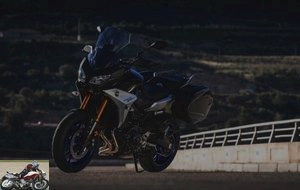
Discovery
This is not a trail. Its raised front axle and its conventional suspension travel make it a machine apart. It’s not a simple, broadly streamlined MT09 roadster either. And this is what makes the originality and the interest of the Tracer 900. This model is a true road which does not forget to be dynamic. On its first release, its design had seduced, offering aesthetic gestures both subtle and powerful. The novelty changes its forms and slightly loses in elegance what it gains in muscular presence. This is particularly the case with its 18-liter tank, whose truncated shoulders with large mesh openings are gaining in presence. They dominate larger and longer scoops to optimize air flow. Quite significant, these elements frame a redesigned front face. It is first of all a new and long bubble with more efficient lines. Equipped with a one-hand adjustment mechanism, it slides over 50 mm via a simple and efficient system, easily accessible, even while driving. Widened and higher, the fork crown also sports a dummy widened central air intake, inlaid between the two tapered optics capped with LEDS. Visually more sport, therefore, but also protection, the very principle of the machine: bringing together fans of more or less distant trips and fans of sporting sensations on the handlebars. Sport AND comfort.
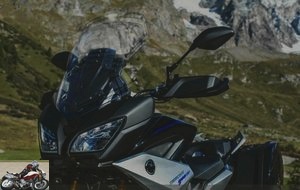
In this idea of long-term accommodation, the rear loop clearly optimizes its forms. Entirely sheathed, it dresses its sides even more carefully. Textured, with worked lines and enlarged surfaces, the seats invite you to travel. The passenger seat is framed by large, redesigned, longer, ergonomic grab handles. They still dominate the integrated anchor points for side cases. Finally, the various side covers are no longer streaked and are undoubtedly easier to maintain..
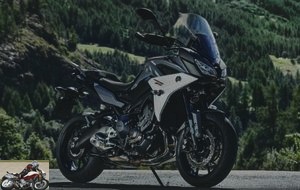
Much of the all-aluminum cycle part of its predecessor, the Yamaha Tracer 900 and 900 GT hardly change. The stern rests on a tubular structure, bolted to the die-cast, diamond-like frame. Composed of two perforated side members, its wide uprights in the front part curve strongly behind the engine. And what an engine this CP3! Yamaha has a weakness for Crossplane (CP) engines, therefore with offset crankpins (see the excellent article by our colleague Jef). With an equivalent architecture, this arrangement gives the particularity of offering a better distributed torque. This name is rather marketing here, because on a three-cylinder, the setting at 120 ° is logical. This 847 cc, twin ACT, 12-valve three-cylinder block features a super-square bore-to-stroke ratio of 78×59.1mm and features high-quality mechanics. It develops 115 hp at 10,000 rpm (84.6 kW) and 8.75 da.Nm at 8,500 revolutions-minutes. All available from low revs and offering the traveler a whole character.
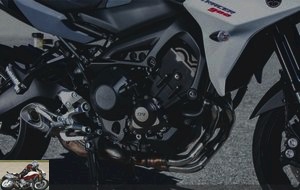
Find the Technical point in the dedicated section.
And as we quickly take a liking to the exuberant character of the three-cylinder, the clutch is now assisted and anti-dribble. Already used on the MT09 roadster, it allows you to drive serenely in brutal mode.
The Tracer are always equipped with efficient electronics, controlled by a throttle control (YCC-T / Yamaha Chip Controlled Throttle). The road roadster thus has three maps (D-Mode) including three engine maps (D-mode), a TCS two-level and disconnectable anti-slip and ABS as standard..
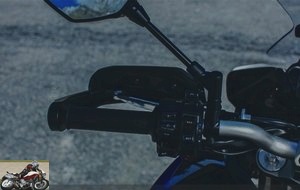
Importantly, the rear geometry is evolving, with an asymmetrical banana swing arm now extended by 60 mm (!), Or 1,500 mm, to reinforce stability. Will it harm the wheelie that the machine is fond of….? It is also the correction of a nasty defect noted on the previous models: the high speed darting. Likewise, the rear shock absorber sees its settings modified for this purpose and to support the increased weight gain. The column angle, very closed, does not vary with 24 ° and the trail is also identical to 100 mm.
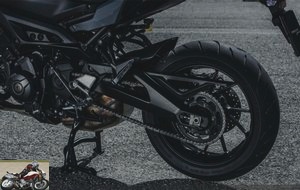
The finish is qualitative, down to the details of the design of the elements and their arrangement. Capping the block, the surfaces of the magnesium cylinder heads are darker. Only the integration of the hoses could be better. The center stand is still standard. The whole still makes up an increasingly attractive machine with a resolutely sporty style and now more opulent. The weight is also increasing, rising to 214 kg (+4), that of the GT is 215 and takes an additional 12 kg with the suitcases..
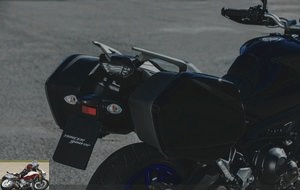
The only regret is that the Quickshifter, a system allowing you to change gears on the fly, is not installed on the base model. Especially since the MT09 is equipped with it…. For this, it will be necessary to choose the super-equipped version Tracer 900 GT.
Specificities Tracer 900 GT
This beautiful set is even more richly equipped as standard on the Tracer 900 GT version: Rigid side bags with a capacity of 22 liters are color matched to the motorcycle. Compact, they do not accommodate a full face helmet.
The dashboard of GT version is a color TFT model (Thin Film Transistor).
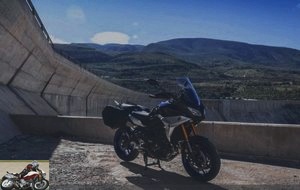
But above all, high-end suspensions equip these machines. At the front, a fully adjustable inverted fork, features golden sheaths. Relaxation and compression adjust respectively on the right and left tube. At the rear, a remote preload adjuster facilitates hydraulic modifications.
On board, the electronics are also progressing: as on the MT09, a rapid shifting system (QSS, Quick Shift System) makes it possible to increase gears on the fly. Sport we tell you.

But also comfort and yes…. With a speed regulator making its appearance. From the MT10, it can be started from fourth to sixth gear, between 50 km / h and 180 km / h. It is operated via a switch located to the left of the handlebars and can be increased or decreased in 2 km / h increments. The system is automatically deactivated when braking, clutching or accelerating. In addition, it has a “Resume” button which allows the system to be reset to the previous setting..
Finally, who says travel says heated grips of course. An undeniable asset for trimming the bollard in any season or at any altitude.
In the saddle
Comfort and ease on board is one of the major development points of the Tracer 900. The contrast between the width of the shoulders and the thinness at the crotch is always surprising. This narrowness makes the Tracer appear taller than it is and helps ensure good downforce. Adjustable, the rider’s seat increases its height by 5 mm and adjusts by 850 mm and 865 mm by turning over an unattractive plastic plate. Composed of multi-density foams, the seats are more ergonomic, limiting pressure points and their more qualitative finish.
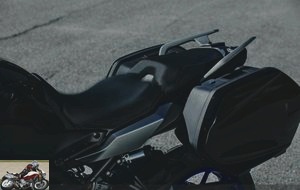
In order to meet its growing touring claims, the Tracer 900 takes particular care of the passenger space. Thus, its grab handles have much better ergonomics: longer, devoid of angles and slightly curved. Also, its footrest plates are now 33 mm longer in order to reduce the flexion of its legs. A point that can cause concern to the pilot; depending on how they place their boots, their heels may strike the accompanying person’s feet or their supports ….
Ergonomics also concerns the pilot. The very thin central section of the frame, obtained by mounting the swingarm axle assembly outside the frame, allows the machine to be clamped easily. The flexion of the legs is rather reduced. But, noticeably set back, the footrest plates maintain a certain dynamic in the general position. Thus, the bust, slightly leaning forward, puts the arms lightly on the large aluminum hanger with variable diameter. Often criticized, the width of the handlebars has been reduced, losing 16.5 mm at the grips. But at the ends, it’s still 100 mm less (!), Reducing the fixings and the size of the handguards. These are also thinner and lighter. What to approach the interface more serenely.
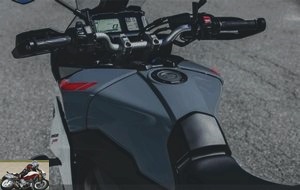
High magnesium-tinted saddles enclose the handlebars, rising above the top triple clamp of the same finish. Around, the fork well hides most of the peripherals and the cable sheathing is satisfactory. Accessibility to the headlights is very good and differentiated adjustment knobs allow a possible adjustment of the simplest..
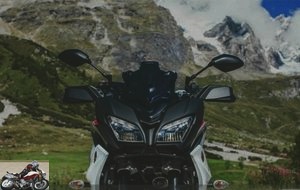
The two machines do not benefit from the same instruments. The Tracer 900, always uses the screen of the previous vintage, taken from that of the XT1200Z Super Tenere and composed of two digital windows. The larger one for the usual information and the smaller one for the ancillary functions. In the first, tachometer, tachometer, clock and engine mapping. The latter is selected, even while driving, on the right stalk by a dedicated push button. In the second, an engaged gear indicator overcomes indications that will be scrolled by a button on the left handle. A first series comprises odometer and two partials, a second odometer and average and instantaneous consumption. A last one displays the ambient temperature, that of the engine and the travel time. The heat level of the optional heated grips may also appear here. The whole is remarkable readability. Note that the TCS traction control only disconnects when stationary.
The Tracer GT offers a color TFT screen for a latest generation display, grouping together identical indications but…. less readable. Indeed, if the support appears vast, the backlit space is in fact reduced. Aesthetic but, in my opinion, less practical and ergonomic.
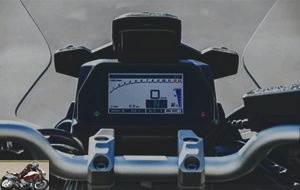
We appreciate the presence of a warning control and a brake lever adjustable in spacing. Too bad, the clutch one does not have it. Practical, a 12-volt outlet adjoins the dashboard and can be supplemented with a second optional. A notorious flaw: the side stand lug, placed behind the left footrest, requires a painful gymkhana. Finally, the central stand is standard, more practical to lubricate the chain and make possible mechanics..
In the city
Sensitive, the reduction of the span of the handlebars brings a new and appreciable ease between the files. Balanced, the Tracer 900 moves naturally in traffic, the upright position allowing a good understanding of the traffic. Logically, the GT requires more attention because of its suitcases. Although narrow, this additional width should be kept in mind when maneuvering. In this regard, Yamaha travelers have a correct turning radius and the good centralization of the masses gives an intuitive handling. Finally, the mirrors, larger, return a clear and effective field.
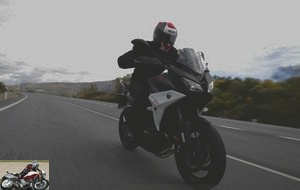
On board the Tracer 900, everything is (deceptively) smooth. Available on any report, the mechanics obediently accompany urban developments, even allowing pick-ups at 2,000 rpm on the last report. The three-cylinder knows how to bend to the constraints of everyday life. A precise selection supports the Yamaha block and its assisted clutch gives it a smooth operation. A characteristic shared by the fork…. Basically, it lacks preload and sinks significantly when taking the brakes, like its predecessor. With its front end of better level, this effect is less clear on the GT.
Docile, especially in Standard mapping and especially B, the three-cylinder knows how to lead you in town with a certain restraint. But if you wake up the sleeping water with a reckless twist of the right handle, the space suddenly narrows. You might as well expand the field of action by setting sail.

Motorway and expressways
Smart, the mechanics are waiting for your good will to catapult the Yamaha road. Especially since the elasticity of the block is still impressive, pushing with force 4,500 revolutions to the red zone (11,000 revolutions / minute). Thus, pulling on the second report makes you blithely exceed the legal motorway…. And we quickly approach the double hecto-kilometers / hour. From now on, do not be afraid, the clandestine darting are not on board. Far from it. The significantly larger wheelbase "wedges" the machine on its path. Holding the course perfectly, the Tracer are fast long distance steeds. And even more comfortable with a bubble easily adjustable while riding. However, even in the high portion, the air flow hits the top of the helmet, but without swirling. We remain in the standard of sports tourism. Arms and shoulders are exposed. Also, depending on the position adopted, the sides of the pilot’s seat may seem a little stiff over the long haul. By stepping back a little, you gain a lot of pleasure and there is no lack of space. Well sheltered, the legs benefit from the work of the long scoops.

If the screen of the Tracer 900 GT is of the most modern, its readability is highly improved. The tilt and size of the display are the cause. Likewise, navigation by small wheel on the right stalk is not an obvious model. Much larger on the standard model, the screen is easy to read…. in black and white, of course. But it performs its function perfectly.
At 130, the boiler pulsates gently at a little over 5,000 rpm. On board the GT, the intuitive cruise control rests the right wrist. But, grafted onto the left stalk, the turn signal control is less accessible. Finally, on the last report, the revivals are less lively, it lowering the regime by 800 revolutions. A hit of 5 and you are again in the assault on the tachometer. To play more, let’s join the secondary network.
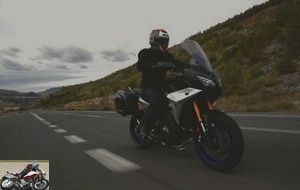
Departmental
The Tracer 900 and GT are easy to handle motorcycles for experienced riders. Their exuberant engine requires a bit of skill, but their agility quickly makes them obvious. However, the liveliness is inevitably less because of, again, the lengthening of the oscillating arm. Now more stable, the Yamaha road requires a little more engagement in the winding. Especially since the handlebars are slightly reduced (-16.5 mm) and its lever arm as well. Finally, the original tire assembly does not help on this point. Already questionable in 2015, the Dunlop D222 certainly serve the machines. Note, however, that adjusting the suspensions significantly improves the dynamic behavior on angle changes and decelerations. Nothing questionable therefore, especially as the holding of course on the angle is improved. And, unchanged, the very closed column angle (24 °), keeps the machines a good cycle part dynamism. Once again, the Tracer 900 GT seems to me less sensitive to this inertia than its false twin. More worked, its depreciation logically improves its evolutions. However, exchanging our machines, they could be modified in depreciation by colleagues during the test day and the opinion of the testers is divided on this point. To confirm.

The general point of agreement remains the highly characteristic mechanics of the block. On the first two reports, underlining its evolutions with a powerful rumble, the Tracer rears up naturally. Particularly efficient from 4,000 to 10,000 revolutions, the three-cylinder impresses with its extension on intermediate ratios. It is a super-elastic, combining the best torque and power. On the small hilly roads of southern Spain, you rarely pass the 4, juggling between two and three…. What a panard this three cylinders !
In basic setting, the fork sinks sharply on strong decelerations. To appreciate a high rhythm, it is good to pre-load the suspension and especially to close the trigger. Precision is then gained while maintaining acceptable comfort. Mass transfers then remain more contained when taking the brakes, especially on the standard Tracer. When going around big throttle, the Tracer is also more homogeneous and does not move like its predecessor..

If Mode A still generates jerks that are too sensitive, Standard mode is almost as responsive and throttle control is now more precise. By adopting a touring look, the Tracers highlight the smoothness of the mechanics, especially in engine B mode. The piloting position offers a compromise rather favorable to touring, but the seats will push you to take a break..
Part-cycle
A major development point, the increased wheelbase by extending the swingarm gives the Tracer a less whimsical behavior. However, this does not really detract from their dynamic capacity. It is hardly that in the pins that this effect is felt more. This is, however, to the benefit of appreciable stability in other driving phases. In addition, a more suitable fitting of tires as well as an adjustment of the suspensions largely mitigate any possible discomfort..
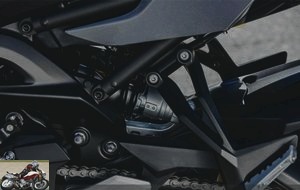
The GT version keeps a head start with its better quality suspensions, both in its dynamic reactions and in comfort..
Braking
The progressive implementation of radial callipers ensures good control of decelerations, leaving the rider to modulate his pressure on the lever, even in difficult grip conditions. Deceleration does not lack power but can sometimes suffer, when driving engaged, the default flexibility of the suspensions. Now more stable, the machine appreciates the braking more on the angle, the front axle locking noticeably less than before. And, here too, the tracer 900 GT makes the difference, delivering even more rigor. Powerful, the standard ABS manages the frame sportily. The rear retarder pedal travel is still a bit long and not consistent enough. A shy hair, the gripper allows however to effectively refine the trajectories in curves.
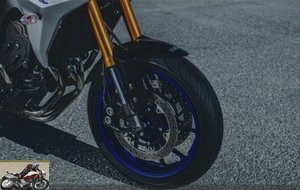
Comfort / Duo
As for the other points, the trip will of course be more pleasant in Tracer 900 GT and the road feel more precise. Announced more comfortable, the seats are not too convincing. The accompanying person benefits from an efficient welcome and complies with the Sport-Touring status of the machines. A test in the passenger seat proves good duo abilities thanks to effective ergonomics of the handles and footrests.
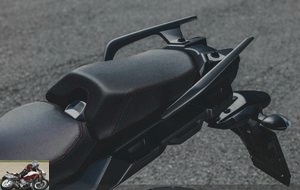
On the standard model, optional soft luggage containing waterproof bags will improve the crew’s trips. But its highly visible tubular fixing structures are hardly engaging.
Consumption
Reading the dashboards, our average consumption, without forcing the handlebars, is 5.8 liters per 100 km. A data to be verified more fully during a next daily test.
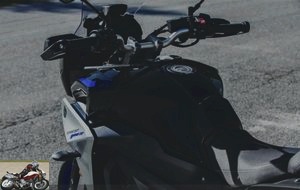
Conclusion
As they age, the Yamaha Tracer 900 admit a little more seriousness, in order to ensure a more assertive Touring performance, especially in the GT version. Paradoxically, it is with the latter that, depending on the test conditions, the most dynamic pleasure in sport driving is retained, as its suspensions make the difference. Overall, the sport / comfort compromise provided by the two Yamaha is convincing. But when it comes to choosing, it’s hard not to be tempted mainly by the qualities and equipment of the Tracer 900 GT. Its only weak point being the unworthy readability of its instrumentation.
Priced at 10,599 €, thus limiting the increase to 100 €, the standard version does not lack advantages: new screen, passenger space, anti-dribble clutch…. But for 1,600 € more, or 12,199 €, its variation raises the model to a new standard.

What to give new sweats to the numerous competition, composed of road or road trails. The closest is the Honda VFR 800 X Crossrunner, claiming 12,849 €, with wiser mechanics and displaying a high weight. At Kawasaki, the Versys 1000, from 13,199 €, must also assume its 250 kg. But its carrying capacity is greater. In addition to the Channel, the Triumph Tiger Sport 1050 requires € 14,000 but is also equipped very well: single-sided, regulator, anti-slip, assisted clutch, engine mode. Here too, its 250 kg will make a clear difference. On the European road trail side, the Triumph Tiger 800 XRX is displayed at € 12,100, the BMW F850GS at € 11,950 before opening the options box.
Well placed, the Yamaha Tracer 900 retain an appreciable dynamic-comfort-agility ratio. A little less sassy, they do not lose their status as road-dryers, well helped by a contained weight. A little more reasonable, they will appeal to bikers looking for an unusual and more rational dynamic versatility. In short, the reason for the more sport is no longer the best…. or at least not the only one of Tracer.
Strong points
Plot 900
- Engine character and availability
- Agility / stability balance of the chassis
- Windscreen easily adjustable while riding
- Ergonomics
- Finishes
- Readability of instruments
Tracer 900 GT
- Engine character and availability
- Agility / stability balance of the chassis
- Efficient suspensions
- Rear shock absorber adjustment
- Windscreen easily adjustable while riding
- Ergonomics
- Finishes
- Numerous equipments
Weak points
Plot 900
- Absence of the shifter
- Firm saddle
- Tires
- Maximum bubble protection
Tracer 900 GT
- Screen readability
- Firm saddle
- Tires
- Maximum bubble protection
The technical sheet of the Yamaha Tracer 900
Standard equipment of the Tracer 900
- 3 engine maps (D Mode)
- ABS braking
- Disconnectable TCS anti-slip
- Assisted anti-dribble clutch
- 41 mm inverted fork adjustable in preload and rebound
- Monocross rear suspension adjustable for preload and rebound
- Height-adjustable windshield, handlebars and rider’s seat
- Hand guards
- LED position lights
- Two radial-mount front calipers
- 12V socket
- Central stand
Additional standard equipment for the Tracer 900 GT
- Fully adjustable inverted front fork with gold sliders
- Rear shock absorber with remote preload adjuster
- Color TFT instrument panel (Thin Film Transistor)
- Speed regulator
- Non-disengaging quickshifter system (QSS)
- Heated grips
- Color-matched hard side panniers
Main accessories
- High windshield
- Additional spotlights
- Heated grips
- Comfort saddle
- Low saddle
- Soft side cases
- Top case
- Tank bag
- Akrapovic full exhaust
The video test of the Yamaha Tracer 900 and GT
Related articles
-
Trace strong and far The impressive commercial success of the Yamaha MTs is a quantified reality: 3,700 MT-09 (including 15% of Street Rallye and Sport…
-
Yamaha Tracer 9 and Tracer 9 GT motorcycle test
Cross-country sprinters 3 cylinders in line, 889 cm3, 119 hp and 93 Nm, 213 kg full made, from 11,499 euros Road trail, sport-touring, road … the names…
-
Pocket cruiser Yamaha and the MT family are pleased to announce the birth to the road of its youngest, the Tracer 700. And yes, more one. And surely…
-
200 hp at 13,500 rpm, 112 N.m at 11,500 rpm, 199 kilos with full fuel, from € 18,499 Is the Crossplane engine an advantage in road use ? Even if the…
-
Yamaha MT-07 2021 motorcycle test
Generic anti-depressant Twin CP2, 689 cm3, 73.4 hp, 67 Nm, 184 kg, 7,299 euros The face of bikers in the medium-displacement segment, the Yamaha MT-07…
-
Thin blade Single cylinder with variable valve timing, 124.7 cm3, 15 hp and 12.4 Nm, 142 kg, 5,299 euros For several years, small sports cars have made a…
-
Backpacker at heart Twin-cylinder CP2 of 689 cm3, 74 hp and 68 Nm, 204 kg full made, 9,699 euros Stopped at the end of 2016 due to Euro 4 standards, the…
-
Roadster Sport-Heritage Fasters Sons Following on from the XSR 700, Yamaha today unveils its new Sport-Heritage XSR 900 roadster in dynamic fashion….
-
Two-Temperaments ! At the end of the 1970s, when motorcycles with large-capacity multicylinder engines weighing a dead donkey have been in vogue for a…
-
Evolution or revolution for the 2018 vintage of the flagship roadster of the MT range ? Unambiguous ambivalence By unveiling, in 2013, the MT09, the…
a two-stroke engine fitted with new technologies is more efficient and less polluting than the current 4-stroke !
As proof, this is the only type of engine authorized on Lake Constance As luck would have it in all areas where Honda is not present, the two-stroke engine is used again
Boating, snowmobile Motobecane was a pioneer with the injection unfortunately not marketed
I remain convinced that common sense will prevail and that the modernized two-stroke will come back to the fore!
Photo of my two mistresses 🤪
Never two without three
The next being acquired
Kawasaki 900 Z1 73. Yellow ✌
[attachment 36028 8DEED3C6-3F5A-481E-9DF7-27CA10F9A9FD.png]
Very good text in the form but only spelling mistakes!
Are you timed to write your articles or what ????? : D